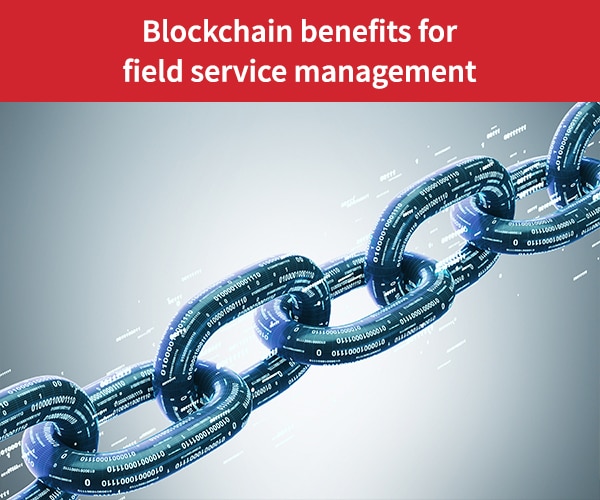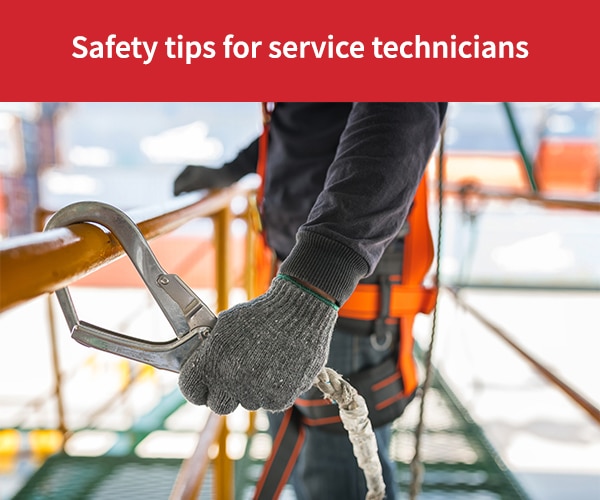
- Big Data
- Customer Satisfaction
- Field Service Management
- Technologies
- Work orders
Using blockchain in field service management
Blockchain technology traces the entire life cycle of service calls to help field service providers improve customer satisfaction and avoid disputes over compliance with contractual commitments. Here’s how.
Today, there’s a lot of buzz about blockchain technology and its role in Bitcoin transactions. But, the technology far exceeds the scope of cryptocurrency. It’s like a large, decentralized accounting book that allows all types of transactions to be almost immediately validated without involvement from a trusted third party.
Blockchain is named because of the way it operates. Blocks of information are created and added to existing blocks, forming a chain. Cryptography is used to ensure that, if one block is tampered with, the data in the blocks that follow are erased.
Network nodes are spread across different computers and servers, making hacking impossible in theory. In addition, blockchain uses a consensus algorithm, which means a “miner” must solve a complex mathematical problem. This is called proof of work.
Ecosystem players join forces
Blockchain uses these different mechanisms to provide the confidence that is lacking in some ecosystems. It can bring together multiple players, even if they are competitors with different interests. More broadly, blockchain can be used for any activities where there is a need for absolute confidence in the information provided.
A report on blockchain challenges published by France Stratégie in June 2018 noted that blockchain provides a vast and unfalsifiable record of transactions. As a result, it has the ability to revolutionize the way transactions related to the transfer of goods and other exchanges between people are controlled, going beyond certified industrial and financial processes.
An internet evolution
According to the report, blockchain will enable the internet to evolve from communications-oriented to value-oriented by resolving problems such as the lack of confidence in, and trusted third-party authorities for, internet transactions.
The banking and insurance industries were the first to adopt blockchain, but trials are currently underway in the logistics, transport, food traceability and pharmaceutical industries. All of these businesses see the value that blockchain can bring them in terms of tracing the complete life cycle of a product, whether it’s food, medicine or a container.
The power of smart contracts
Because it operates without a certification body, blockchain can validate transactions without human intervention using smart contracts that are self-executed based on predefined rules. The transaction is triggered by an event that can be a date, an amount or other information sent by a connected sensor.
The potential in field service management
It’s easy to understand blockchain’s advantages when you look at the benefits it brings to field service management. Blockchain would allow field service providers to capture and trace every defined stage in any type of service activity from the time of the initial customer request through invoicing. For example, the signing of the service report could trigger closing of the ticket.
Connected sensors can authenticate operations
Blockchain is closely linked to the Internet of Things. Data collected by connected objects can be used to authenticate and timestamp transactions. For example, a sensor on a device can report a malfunction and automatically trigger a service request. A blockchain record provides an unfalsifiable account of the health of a piece of equipment, capturing when it failed, when it was repaired and who repaired it.
Meet contractual commitments, avoid litigation
All stakeholders — customers, dispatchers, technicians, managers — can share these certified records. This transparency will improve customers satisfaction and eliminate lawsuits. With smart contracts, payment is made when the service is complete and verified.
Because it tracks every activity that’s executed, blockchain provides the proof of work needed in field service management. Compliance with commitments such as response time or restoration time in service level agreements (SLAs) are no longer subject to interpretation. This is important because these metrics can be used as the basis for financial penalties against field service providers.
Field service providers can also use blockchain to increase visibility into their spare parts supply chain. They can follow each stage in the parts delivery process to reduce the risk of stock shortages.
Combine blockchain and 3D printing
Going even further, blockchain can be used in combination with 3D printing, giving field service providers the opportunity to reduce the risks associated with out-of-stock parts by printing the required parts on-site, on-demand.
However, additive manufacturing must be carefully balanced with license management. Field service providers must ensure the number of parts printed does not exceed the number stipulated in the contract. And customers need a way to ensure the file received is genuine and has not been tampered with. Installing a defective part in customer equipment could have serious consequences.
Blockchain can resolve these types of problems related to intellectual property. For example, companies such as Italian startup, 3D-Token, issue tokens, called 3DT, that serve as virtual currency for buying and exchanging print files in .stl format.
Use blockchain for HR management support
Finally, blockchain can even be used to verify and validate candidate qualifications, references and initial training to improve human resources management. A growing number of schools are using blockchain to certify their degrees.
In the future, it will be more difficult for technicians to embellish or fabricate resumes. Once technicians are hired, blockchain can optimize management of their employment contracts and use geolocation data to track their work hours.
Our similar articles.
-
- Mobility
- Technician
- Customer Satisfaction
Ensure your electronic reports are not missing information
October 28, 2021 -
- Maintenance
- Technician
- Security
- Technicien
- Work orders
- Mobile app
Ensuring the safety of maintenance technicians
November 25, 2020 -
- Maintenance
- Field Service Management
- Software
9 Practical Steps to Deploy Field Service Management Software
July 19, 2018


